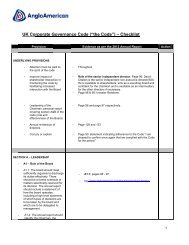Anglo American Annual Report 2012
Anglo American Annual Report 2012
Anglo American Annual Report 2012
- No tags were found...
You also want an ePaper? Increase the reach of your titles
YUMPU automatically turns print PDFs into web optimized ePapers that Google loves.
1. ACCOUNTING POLICIES continuedAmounts deferred to date which do not relate to existing components of theorebody will be written off to reserves.The following new or amended IFRS accounting standards not yet adoptedare not expected to have a significant impact on the Group:IFRS 10 replaces the portion of IAS 27 that addresses accounting forconsolidated financial statements and SIC-12 Consolidation – SpecialPurpose Entities. IFRS 10 provides a single basis for consolidation with a newdefinition of control. The standard is effective for annual periods beginning onor after 1 January 2014 although early adoption is permitted.IFRS 13 Fair Value Measurement provides a single framework for all fairvalue measurements and applies to annual periods beginning on or after1 January 2013.The amendment to IAS 1 Presentation of Financial Statements requires itemsto be grouped in other comprehensive income based on whether those itemsare subsequently reclassified to profit or loss. The amendment is to be appliedfor annual periods beginning on or after 1 July <strong>2012</strong>.The amendment to IAS 19 Employee Benefits is to be applied retrospectivelyfor annual periods beginning on or after 1 January 2013.Amendments have been made to IAS 27 Consolidated and Separate FinancialStatements and it has been reissued as IAS 27 Separate FinancialStatements. The revised standard prescribes the accounting and disclosurerequirements for investments in subsidiaries, joint ventures and associateswhen an entity prepares separate financial statements. The accounting anddisclosure requirements for investments in subsidiaries, joint ventures andassociates in consolidated financial statements are prescribed by IFRS 10,IFRS 11 and IFRS 12. The revised standard is to be applied for annual periodsbeginning on or after 1 January 2014 although early adoption is permitted.Amendments have been made to IAS 28 Investments in Associates and ithas been reissued as IAS 28 Investments in Associates and Joint Ventures.The revised standard prescribes the application of the equity method whenaccounting for investments in associates and joint ventures. The revisedstandard is to be applied for annual periods beginning on or after1 January 2014 although early adoption is permitted.Amendments to IFRS 1 Government loans and to IFRS 7 Disclosures –Offsetting Financial Assets and Financial Liabilities are effective for annualperiods beginning on or after 1 January 2013.The amendment to IAS 32 Financial Instruments – Presentation is effectivefor annual periods beginning on or after 1 January 2014.Critical accounting judgements and key sources of estimationand uncertaintyIn the course of preparing financial statements, management necessarilymakes judgements and estimates that can have a significant impact on thefinancial statements. The most critical of these relate to estimation of theore reserves and useful economic lives of assets, impairment of assets, fairvaluation of net assets on acquisition, restoration, rehabilitation andenvironmental costs, retirement benefits, financial assets and liabilities at fairvalue through profit and loss and contingent liabilities. These are detailedbelow. The use of inaccurate assumptions in calculations for any of theseestimates could result in a significant impact on financial results.Ore Reserve estimates and useful economic lives of assetsWhen determining Ore Reserves, which may be used to calculate depreciationon the Group’s mining properties, assumptions that were valid at the time ofestimation may change when new information becomes available. Any changescould affect prospective depreciation rates and asset carrying values.The calculation of the unit of production rate of amortisation could be impactedto the extent that actual production in the future is different from current forecastproduction based on proven and probable mineral reserves. Factors which couldimpact useful economic lives of assets and Ore Reserve estimates include:• changes to Proved and Probable Reserves• the grade of Ore Reserves varying significantly from time to time• differences between actual commodity prices and commodity priceassumptions used in the estimation of mineral reserves• renewal of mining licences• unforeseen operational issues at mine sites• adverse changes in capital, operating, mining, processing and reclamationcosts, discount rates and foreign exchange rates used to determinemineral reservesFor property, plant and equipment depreciated on a straight line basis overits useful economic life, management reviews the appropriateness of usefuleconomic life at least annually and any changes could affect prospectivedepreciation rates and asset carrying values.Impairment of assetsIn making assessments for impairment, management necessarily applies itsjudgement in allocating assets that do not generate independent cash flowsto appropriate CGUs, and also in estimating the timing and value of underlyingcash flows within the calculation of recoverable amount. Factors which couldimpact underlying cash flows include:• commodity prices and exchange rates• timelines of granting of licences and permits• capital and operating expenditure• available reserves and resources and future production profileSubsequent changes to the CGU allocation or to the timing of or assumptionsused to determine cash flows could impact the carrying value of therespective assets, see note 14.Fair valuation of net assets on acquisitionThe Group applies the acquisition method of accounting for acquisitions.This requires all identifiable assets, liabilities and contingent liabilities ofa subsidiary, joint venture entity or an associate acquired on the date controlis obtained, which can be measured reliably, to be recognised at theirprovisional fair values at the date of acquisition.The fair value of identifiable assets and liabilities is determined usingdiscounted cash flows or other valuation techniques using assumptionsconsidered to be reasonable and consistent with those that would be appliedby a market participant. The assessment of assumptions used in determiningthe fair value of identifiable assets and liabilities is inherently subjective andthe use of inaccurate valuation assumptions could result in a significantimpact on financial results.Restoration, rehabilitation and environmental costsCosts for restoration of site damage, rehabilitation and environmental costsare estimated using either the work of external consultants or internalexperts. Management uses its judgement and experience to provide for andamortise these estimated costs over the life of the mine.Retirement benefitsThe expected costs of providing pensions and post employment benefitsunder defined benefit arrangements relating to employee service during theperiod are determined based on financial and actuarial assumptions.Assumptions in respect of the expected costs are set after consultation withqualified actuaries. While management believes the assumptions used areappropriate, a change in the assumptions used would impact the Group’sother comprehensive income going forward.Financial assets and liabilities at fair value through profit and lossThe fair value of the Group’s financial assets and liabilities held at fair valuethough profit and loss represents the market value of quoted investments andother traded instruments where available. For financial assets and liabilitiesheld at fair value through profit and loss for which market prices are notreadily available, fair value is determined using discounted cash flows orother valuation techniques using assumptions considered to be reasonableand consistent with those that would be used by a market participant.The assessment of assumptions used in applying valuation techniques isinherently subjective and the use of inaccurate assumptions could resultin a significant impact on financial results.Contingent liabilitiesOn an ongoing basis the Group is a party to various legal disputes, theoutcomes of which cannot be assessed with a high degree of certainty.A liability is recognised where, based on the Group’s legal views and advice,it is considered probable that an outflow of resources will be required to settlea present obligation that can be measured reliably. Disclosure of othercontingent liabilities is made in note 35 unless the possibility of a loss arisingis considered remote.Financial statements<strong>Anglo</strong> <strong>American</strong> plc <strong>Annual</strong> <strong>Report</strong> <strong>2012</strong> 147



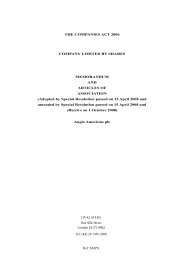
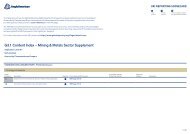
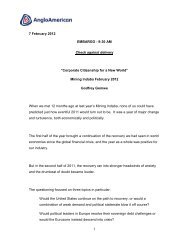
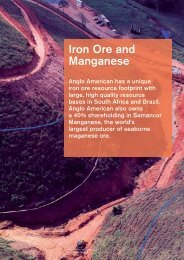
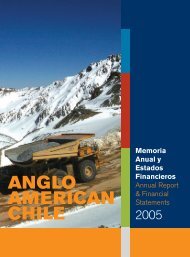
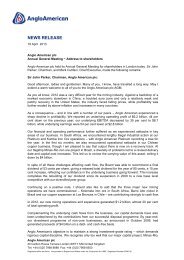
![English PDF [ 189KB ] - Anglo American](https://img.yumpu.com/50470814/1/184x260/english-pdf-189kb-anglo-american.jpg?quality=85)


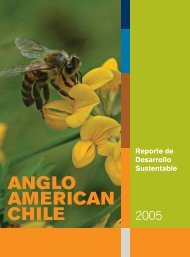
![pdf [ 595KB ] - Anglo American](https://img.yumpu.com/49420483/1/184x260/pdf-595kb-anglo-american.jpg?quality=85)
![pdf [ 1.1MB ] - Anglo American](https://img.yumpu.com/49057963/1/190x240/pdf-11mb-anglo-american.jpg?quality=85)
